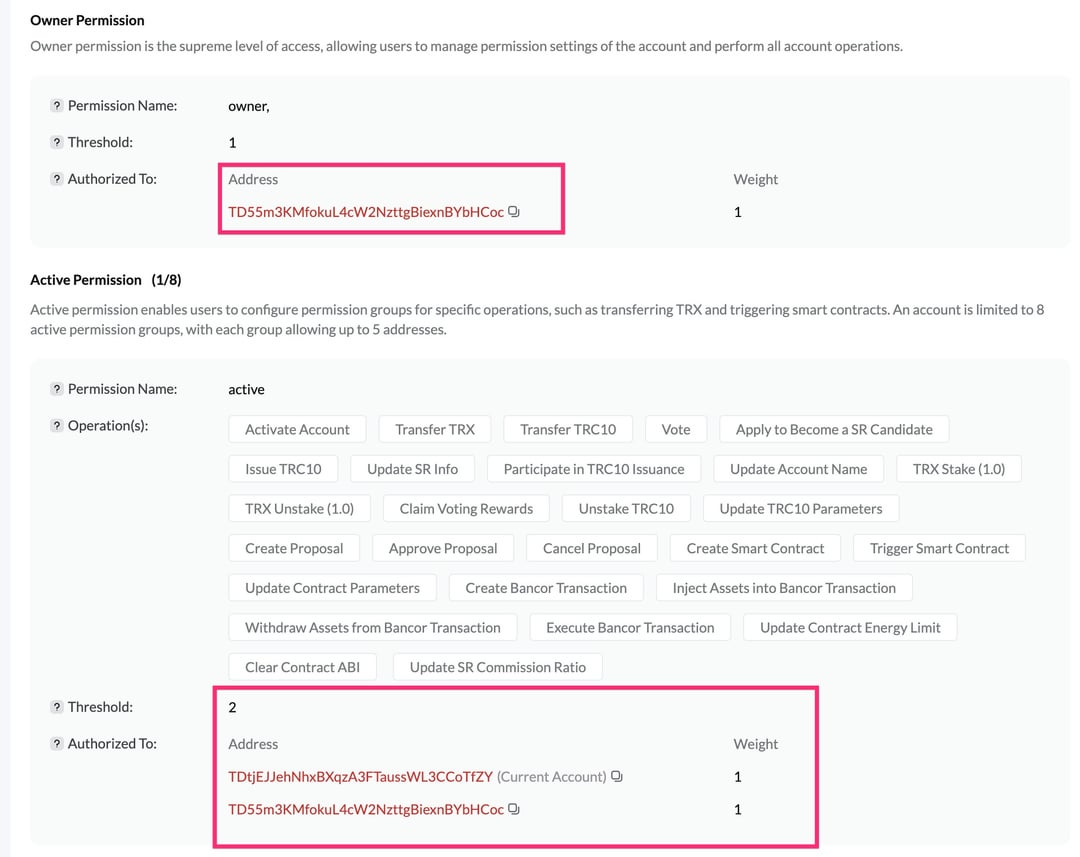🕵️♀️ Inside the TRON Gas Honeypot
How fraudsters use delegated permissions on TRON to drain well-meaning helpers, and how to stay safe.
1. The Bait: "Just Need TRX for Gas"
The setup usually lives in YouTube comments, Telegram rooms, or Reddit threads. Someone claims they hold 5,000 USDT but lack the TRX needed to cover transfer fees. They post the full seed phrase and frame it as a chance for you to share in their good fortune.

On TronScan the account looks legitimate—high USDT balance, zero TRX, and no obvious red flags… yet.
2. The Trap: Hidden Owner Permission
Once you import the seed into a wallet or TronLink, you try to send USDT. The transaction stalls because the account lacks TRX. Victims often top it up with a few tokens—just enough for a transfer. What they miss is the Owner Permission tab on TronScan.

Screenshot 2 reveals the con: the scammer already delegated Owner Permission to a different address. That controller can sign any transfer as soon as TRX appears.
3. The Drain: Delegated Wallet Sweeps Your TRX
Soon after you fund the wallet, an automated bot (or the scammer manually) signs from the delegated owner account. There is no hurry for the fraudster. The TRX you donated disappears but you cannot broadcast a USDT transfer (and you never could). You hold the seed, but not the authority.
Victims often believe timing is the key — if they click "Send" fast enough, maybe they can beat the fraudster. That is a fallacy. The delegated owner signs after your deposit is confirmed, no race required, so you cannot outpace the theft.

Screenshot 3 captures the delegated owner executing the outbound TRX sweep. No USDT ever leaves the wallet; only your freshly added gas vanishes.
How This Differs from ETH Honeypots
On Ethereum-style honeypots, attackers usually share a private key to a wallet that appears to hold ERC-20 tokens. The moment you send ETH for gas, a pre-authorized pull or mempool sniping bot moves the assets first, leaving you with nothing. The scam hinges on superior automation.
The TRON setup is more structural: the original seed is still valid, but Owner Permission (and often Active Permission) are reassigned. The blockchain enforces the delegated controller, so there is nothing to race—your TRX is gone as soon as it lands. Understanding this permission model is a stepping stone to mastering how TRON (and other delegated-proof-of-stake networks) secure accounts.
Two Ways the Trap Locks You
Fraudsters reuse the same bait but enforce control in two main ways. Spotting either sign means the wallet is a trap.
Owner Permission Takeover
In the first screenshots, the scammer moved Owner Permission (and often Active Permission) to a second address. Once you add TRX, that controller signs the withdrawal after your deposit is confirmed, so there is no chance to be faster.
Multisig Gas Trap
Here is another case where a wallet showed about $8,700 USDT and shared its seed phrase. Helpers kept sending TRX and never got it back.

Even when TronCastle supplied energy instead of TRX, the USDT stayed locked because the scammer held the second multisig signature.
Investigators hoped that avoiding TRX fees would help, but multisig formed a second gate. Without the scammer's sign-off, nothing moves. It is a reminder that the same security tools we rely on can be misused.
Community responders stressed the takeaway: learn the architecture first. Understanding TRON's permission tree—Owner, Active, and multisig thresholds—keeps you safer and helps you build trustworthy tools.
How to Audit a TRON Wallet Before Sending TRX
Step 1: Inspect Permissions
Open TronScan, paste the address, and review the Permissions tab. If you see unfamiliar controller addresses, walk away.
Step 2: Check Recent Transactions
Look for repeated small TRX deposits followed by instant outbound transfers. That pattern signals the delegated owner is actively sweeping new funds.
Step 3: Validate Contract Approvals
Under Token Balances, confirm there are no suspicious smart contracts with spending rights. Some scams layer contract approvals on top of owner delegation.
Step 4: Assume Public Seeds Are Burned
If a seed phrase is public, treat it as compromised. The legitimate owner would rotate permissions immediately if it were accidental. Use every opportunity to deepen your understanding of TRON permissions—knowledge makes you harder to fool.
Protection Checklist
- ✅ Never send TRX to strangers promising to share stablecoins.
- ✅ Confirm you control Owner and Active permissions before funding any imported seed.
- ✅ Use hardware wallets or multisig for real funds so attackers cannot silently reassign control.
- ✅ Educate friends: TronScan that looks generous can quickly become a TronScam.